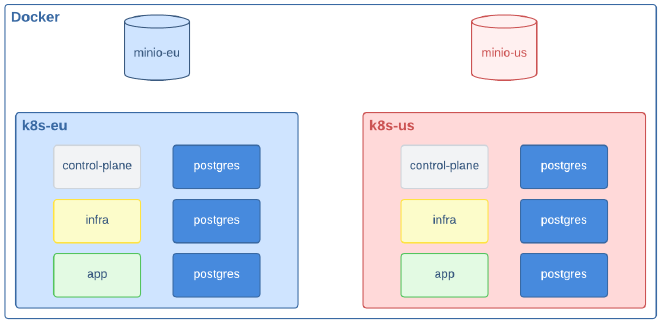CNPG Playground: A New Learning Environment for Postgres in Kubernetes

Table of Contents
Welcome CNPG Playground, a local learning environment for exploring CloudNativePG and PostgreSQL in Kubernetes. Using Docker and Kind, it simulates real-world scenarios, enabling developers and DBAs to experiment with PostgreSQL replication across two clusters. Designed for hands-on learning, CNPG Playground provides an accessible entry point for testing configurations and features, with plans for future enhancements and community collaboration.
I’m excited to share a new project I’ve been working on with Leonardo Cecchi as part of the CloudNativePG community, in preparation for the training session that we will have at the next PostgreSQL Europe Conference in Athens: CNPG Playground.
This lightweight, local learning environment is designed to help developers, DBAs, and PostgreSQL enthusiasts dive into the world of running PostgreSQL in Kubernetes with CloudNativePG in a simple and accessible way.
What Is CNPG Playground? #
At its core, CNPG Playground is a ready-made environment that leverages Docker and Kind (Kubernetes in Docker) to quickly set up a local space for testing, learning, and experimenting with CloudNativePG. It’s perfect for gaining hands-on experience without the hassle of complex setups or cloud infrastructure. Moreover, it simulates a real-world scenario with two Kubernetes clusters in different regions, allowing PostgreSQL to replicate across these environments using object stores. Kind creates the Kubernetes clusters, while MinIO (running directly in Docker, outside the Kind clusters) simulates a typical object store in the cloud.

Why We Built This #
Running stateful workloads like PostgreSQL in cloud-native applications can be challenging. While CloudNativePG simplifies Postgres management on Kubernetes, we recognized the need for a more accessible learning context.
CNPG Playground was created to provide developers and DBAs a straightforward, low-barrier entry point to experiment with the operator in a local setting. It’s a space to test configurations, explore features like high availability, and see how CloudNativePG integrates with Kubernetes—all without needing a full production setup. There’s no better way to learn than by getting your hands dirty, and the playground offers a guided way to try out CloudNativePG’s capabilities in a slow-paced environment conducive to learning.
How to Get Started #
Ready to give it a try? Head over to the GitHub repository for instructions. You’ll need Docker and Kind installed, and once you’ve got that, you’re all set.
I’m proud of how this project has come together and excited to see how the community will use it. If you try it out and have any feedback, suggestions, or questions, feel free to open an issue or join the conversation on the CloudNativePG community channels.
This is just the beginning! We plan to utilize this playground in future training sessions with EDB, and we’re committed to improving and building upon it. Of course, it’s open-sourced and owned by the community.
Let’s build, learn, and improve together!
Stay tuned for the upcoming recipes! For the latest updates, consider subscribing to my LinkedIn and Twitter channels.
If you found this article informative, feel free to share it within your network on social media using the provided links below. Your support is immensely appreciated!
Cover Picture: “Baby Elephant Running“.